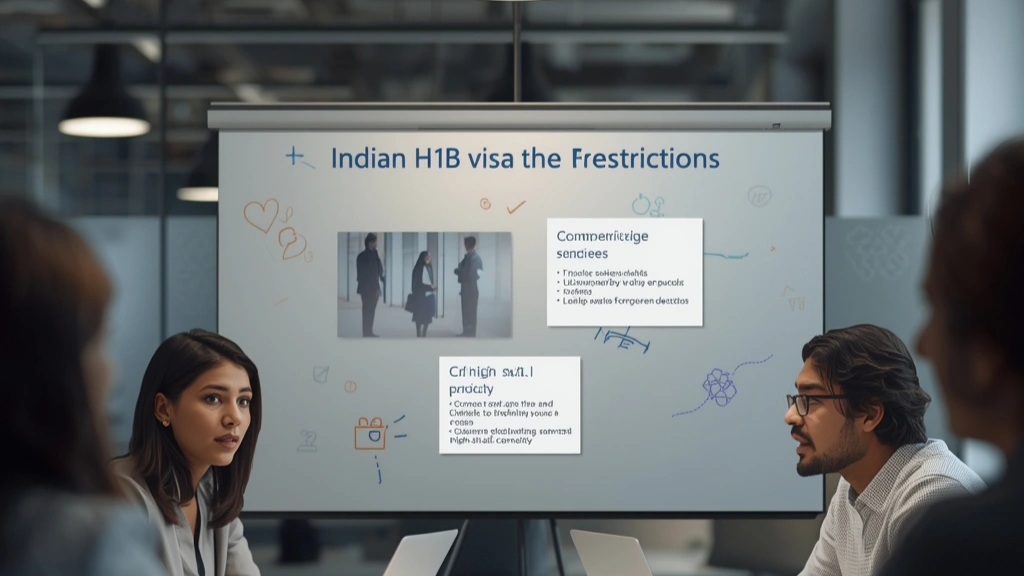H1B Visa Restrictions and Their Global Impact
The United States has always been a top destination for skilled professionals, especially in technology and engineering. Among the various visa programs, the H1B visa has long been central to the global movement of talent, particularly from India. But in recent years, H1B visa restrictions have become a subject of intense debate. New rules, higher costs, and an uncertain immigration climate are reshaping the future for international workers and the companies that depend on them.
This article takes an in-depth look at the latest developments, including the controversial $100,000 fee proposal, the H1B visa policy change, and the ripple effects on the Indian IT industry visa impact. By examining questions raised by workers, businesses, and policymakers, we can better understand how these shifts may alter the landscape of skilled migration and the U.S. tech sector.
What is the new H-1B visa $100,000 fee?

One of the most controversial proposals linked to the latest H1B visa policy change is the introduction of a steep $100,000 application fee. This idea represents an unprecedented escalation from the current range of a few thousand dollars that companies typically pay for each petition. The aim of this measure is twofold:
- To discourage large outsourcing companies, particularly from countries like India, from filing tens of thousands of petitions each year.
- To generate revenue that can be funneled into U.S. workforce development programs.
If implemented, this fee would dramatically alter the way companies approach hiring foreign talent. The U.S. immigration restrictions IT workers have faced in the past largely focused on eligibility criteria or quotas. This, however, is a financial barrier designed to reshape demand.
Critics argue that such a fee effectively acts as a filter against smaller firms and could be considered discriminatory. For industries reliant on high volumes of international hires, particularly IT consulting and services, the H1B visa hike would be financially crushing.
Untold Announcement– National Cooperative Policy 2025
Does the fee affect current H-1B visa holders?
A major concern for workers already employed in the United States under H1B status is whether they will be directly impacted. Current information suggests that the H1B visa hike would only apply to new applications or extensions filed after the policy is enacted.
That means if someone is already employed and not seeking a new sponsor, they may not feel the immediate impact. However, the knock-on effect could still be significant. Employers might become more hesitant to extend contracts or file renewals if the associated cost is prohibitive.
Here’s a simple table breaking it down:
| Category | Impact of $100,000 Fee |
|---|---|
| Current H-1B visa holders (already approved) | ❌ No direct impact |
| Extensions for existing H-1B holders | ✅ Yes, employers may need to pay higher fees |
| New H-1B applicants | ✅ Yes, full $100,000 fee applies |
| Dependents (H-4 visa holders) | ❌ Not directly affected |
This secondary consequence adds another layer of complexity. Even though existing employees are technically exempt from paying higher fees themselves, the H1B visa restrictions indirectly threaten job stability and long-term planning for both workers and employers.
How long will the H-1B restrictions last?
The duration of any immigration reform is notoriously unpredictable. Historically, U.S. immigration restrictions IT workers have fluctuated depending on the political climate, economic conditions, and lobbying from influential business groups.
Analysts suggest that if the current proposals are passed, the changes may remain in place for at least several years. The rationale behind the H1B visa policy change is rooted in long-term workforce protectionism, which is unlikely to disappear quickly.
That said, courts and industry lobbying groups could influence how long the restrictions remain effective. It is also worth noting that immigration rules can shift dramatically with new administrations, meaning the Indian IT industry visa impact could look very different five years from now.
What are the Restrictions in H-1B of USA
| Restriction | Meaning |
|---|---|
| $100,000 H-1B fee | Employers must pay $100k for new petitions from outside U.S. |
| Entry restriction | No entry if the fee isn’t paid |
| Higher prevailing wages | Jobs must meet stricter pay levels |
| Prioritization of high-skill roles | Preference for higher-paid, specialized jobs |
| Exemptions | Universities, nonprofits, and national-interest cases spared |
| Current holders unaffected | Existing H-1Bs inside U.S. not directly impacted |
Who is exempt from the new H-1B rules?

While the most publicized part of the reform is the H1B visa hike, exemptions are likely to exist for certain groups. Historically, U.S. universities and nonprofit research organizations have enjoyed lighter restrictions when sponsoring foreign workers.
If similar exemptions are carried forward, then academics and researchers may be shielded from the harshest financial burdens. However, private IT companies, particularly from India, are expected to bear the brunt of the new system.
This is critical because the Indian IT industry visa impact could ripple across outsourcing contracts, tech service delivery, and cross-border innovation. Smaller startups that rely on international developers may also struggle to compete if they are excluded from exemptions.
How will Indian IT companies be affected?
The Indian IT industry visa impact is arguably the most significant dimension of these reforms. For decades, India has been the largest source of H1B visa holders, with top firms filing tens of thousands of petitions annually. These companies supply IT services, consulting, and engineering expertise to U.S. firms at competitive costs.
The new H1B visa restrictions and fee hikes threaten to disrupt this long-standing arrangement. Analysts forecast several consequences:
- Rising operational costs: With fees skyrocketing, Indian IT firms may have to pass costs on to U.S. clients, reducing competitiveness.
- Shift in hiring patterns: Companies may pivot to hiring locally in the United States, though this undermines the original value proposition of outsourcing.
- Diversification of markets: Firms could expand more aggressively into Europe, Southeast Asia, or Canada to offset losses in the U.S. market.
- Reduced workforce mobility: Employees who once viewed the H1B pathway as accessible may find opportunities shrinking.
Here’s a simple table showing the main effects:
| Area of Impact | Effect on Indian IT Companies |
|---|---|
| Operational costs | ✅ Significant increase due to $100,000 fee |
| Hiring patterns | 🔄 Shift toward more local U.S. hires |
| Market diversification | 🌍 Expansion into Europe, Canada, and Asia |
| Workforce mobility | ⛔ Reduced opportunities for employees abroad |
| Client relationships | 💲 Higher service costs passed to U.S. clients |
The result is that both Indian businesses and U.S. clients could suffer. The H1B visa policy change does not occur in isolation; it reverberates across contracts, investments, and strategic decisions in both nations.
What legal challenges could arise from the crackdown?
Whenever sweeping immigration reforms are introduced, legal disputes are almost inevitable. The proposed H1B visa restrictions and the dramatic H1B visa hike could be challenged on several grounds:
- Discrimination claims: If rules disproportionately affect workers from specific countries, particularly India, lawsuits may argue that the policy violates international trade agreements.
- Administrative overreach: Critics may claim that the Department of Homeland Security or U.S. Citizenship and Immigration Services lacks the authority to impose such high fees without congressional approval.
- Impact on competitiveness: Business associations could sue by arguing that U.S. immigration restrictions IT workers undermine the country’s economic competitiveness.
In past cases, courts have blocked or modified similar restrictions. However, even temporary enforcement can create long-term uncertainty, forcing both employees and companies to reevaluate their strategies.
Recommended Reviews:– Scheme for Unemployed Graduates
The broader consequences for U.S. innovation
While much attention is paid to the Indian IT industry visa impact, the larger question is how America’s innovation pipeline may be disrupted. For decades, H1B professionals have been integral to Silicon Valley and other tech hubs. They contribute not only to coding and engineering but also to research, product development, and leadership roles.
If the new H1B visa restrictions discourage companies from hiring globally, the U.S. risks losing its edge in attracting top talent. Countries like Canada and Australia with more welcoming policies may absorb the talent pool. Meanwhile, American firms could face shortages in specialized skills, slowing down growth in areas like artificial intelligence, cybersecurity, and cloud infrastructure.
The H1B visa policy change might therefore protect some domestic jobs in the short term but at the cost of long-term global competitiveness.
Balancing protectionism with global realities
Policymakers argue that immigration reforms are designed to safeguard U.S. workers, but globalization complicates this goal. Technology services are not bound by geography. If firms cannot bring skilled professionals into the U.S., they may simply move projects offshore.
This is why the H1B visa hike could backfire. Instead of boosting local employment, it could accelerate the outsourcing of entire projects to India or Eastern Europe. The U.S. immigration restrictions IT workers therefore may not achieve their intended purpose and could instead create inefficiencies in the global supply chain.
The human dimension of visa reform

Behind every statistic are real people whose lives are profoundly affected by these policies. For many Indian professionals, the H1B visa is not just a work permit—it is the foundation of a dream to build a future in the United States. The uncertainty created by constant H1B visa policy change has emotional and psychological consequences. Families face stress about whether they can stay, whether children’s education will be disrupted, or whether years of effort could collapse overnight.
The Indian IT industry visa impact also has a personal angle. Employees waiting years for green card approval may suddenly find themselves priced out of renewals. This instability leads to brain drain where talented professionals choose countries with more stable pathways to residency.
Global diplomatic implications
Immigration reforms are rarely just domestic issues. The H1B visa restrictions strain U.S.-India relations, as India is the largest beneficiary of the program. Business leaders and diplomats frequently raise concerns that restrictive policies send a negative message.
The H1B visa hike also adds tension to trade negotiations. As both nations deepen economic ties, visa restrictions become a recurring flashpoint. Indian policymakers may push back, demanding fairer treatment for their skilled workforce. This could influence broader partnerships in defense, technology, and global governance.
Looking ahead: Possible scenarios
What lies ahead for the H1B program? Several scenarios are possible:
- Full enforcement of restrictions: The $100,000 fee and new rules are implemented, leading to a sharp decline in applications.
- Partial modification after legal challenges: Courts reduce or strike down parts of the policy, softening the blow.
- Policy reversal under new leadership: A future administration prioritizes attracting global talent and rolls back restrictions.
Each path carries significant implications for the Indian IT industry visa impact and for the competitiveness of the U.S. economy.
H1B Visa FAQs of 2025
Q. What are the disadvantages of an H-1B visa?
Limited job flexibility, long green card wait, employer dependence, and restricted work options for dependents.
Q. What are the new rules for H-1B visa?
$100,000 fee for new petitions, higher wages required, and prioritization of high-skilled, higher-paid roles.
Q. Which visa is better than H-1B?
O-1 visa for extraordinary ability or L-1 visa for intra-company transfers may suit certain professionals
Q. Why do Indians get most H1B visas?
High number of skilled IT professionals and strong presence in U.S. technology and consulting sectors.
Q. What is the 60 days rule for H-1B?
H-1B workers have 60 days to find a new employer or leave the U.S. after job termination.
Conclusion
The future of skilled migration to the United States hangs in the balance. The H1B visa restrictions, combined with the proposed H1B visa hike, represent one of the most significant immigration shifts in decades. While the stated goal is to protect U.S. workers, the ripple effects extend across continents, industries, and families.
The H1B visa policy change forces Indian IT firms to rethink strategies, pushes professionals to explore other destinations, and challenges America’s reputation as a magnet for talent. As legal battles unfold and diplomatic tensions rise, the debate will continue to shape the future of work in a globalized world.
The critical questions—how long restrictions will last, who will be exempt, and how companies will adapt—remain unanswered. What is clear is that the U.S. immigration restrictions IT workers are not just an isolated policy move; they are a turning point in how nations compete for the brightest minds.
Further Readings:
- Wisconsin Emergency Powers Bill 2025
- Waqf Bill Supreme Court Judgement 2025
- Cybersecurity for Small Business: Protect Data & Ensure Growth in 2025
- National Cooperative Policy 2025: India’s Cooperative Growth


There is noticeably a bundle to know about this. I assume you made certain nice points in features also.
Appreciate it for helping out, excellent information.
I was very pleased to find this web-site.I wanted to thanks for your time for this wonderful read!! I definitely enjoying every little bit of it and I have you bookmarked to check out new stuff you blog post.
Real great visual appeal on this website , I’d value it 10 10.
Very interesting subject, regards for posting. “Time flies like an arrow. Fruit flies like a banana.” by Lisa Grossman.